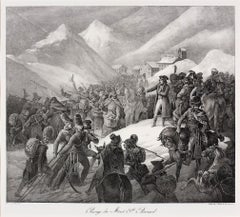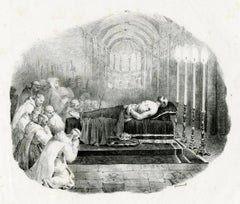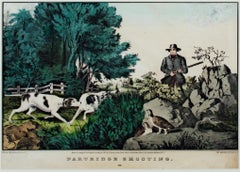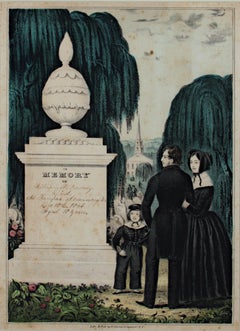Jean Louis Andre Theodore Gericault Prints and Multiples
French, 1791-1824
Théodore Géricault was born in Rouen in 1791 into a wealthy family from the Manche region. His father, a magistrate and wealthy landowner, ran a tobacco factory. The family moved to Paris around 1796, and in 1810 Théodore Géricault entered Carle Vernet's studio, where he met his son Horace. He then studied with Pierre-Narcisse Guérin before enrolling on February 5, 1811 at the École des Beaux-Arts in Paris, where he pursued a classical training based on copying the masters at the Louvre Museum.
Géricault was expelled from the École des Beaux-Arts in 1812 for his misconduct; he then rented a back store on rue de la Michodière, where he painted one of his first masterpieces, a portrait of an officer of the imperial guard (the Lieutenant Dieudonné) charging while on horseback. This painting was exhibited at the 1812 Salon and won him the gold medal at the age of 21! Géricault became a sought-after painter, specializing in military subjects.
Géricault falled in love with his aunt Alexandrine Caruel de Saint-Martin (the wife of his mother's brother). Aged 28 years younger than her husband, she was only 6 years older than him. From this affair, which lasted for many years, a son Georges-Hippolyte was born in 1818.
After a short engagement in King Louis XVIII's Company of Grey Musketeers, Géricault, disappointed at not winning the Prix de Rome, spent two years in Italy. On his return in 1817, he embarked on the creation of his masterpiece, The Raft of the Medusa, which was exhibited in the Louvre in 1819 and was negatively received by the critics.
The presentation of the Raft in London in 1820 brought Géricault to the English capital, first for a two-month period between April and June 1820, then again in 1821 after a return to the continent and a stay in Brussels. The painting was triumphantly received in England (partly for the opposite political reasons to those that had led to its unsuccessful reception in France), and 50,000 visitors flocked to Bullock's gallery where it was exhibited during six months.
In November 1821, Géricault returned home very weakened by a venereal disease contracted probably during his stay in England. He fell off his horse several times, and in August 1823 broke his back in a fall. He died at the age of thirty-two on January 24, 1824, after a long agony.to
2
Overall Width
to
Overall Height
to
3
1,181
941
921
824
2
2
1
1
1
1
2
2
Artist: Jean Louis Andre Theodore Gericault
Passage du Mont Saint-Bernard
By Jean Louis Andre Theodore Gericault
Located in Fairlawn, OH
Theodore Gericault (1791-1824)
Passage du Mont Saint-Bernard
Lithograph, 1822
Signed and titled in the stone
As published in Arnault "Vie politique et militaire de Napoleon"
Conditio...
Category
1820s Romantic Jean Louis Andre Theodore Gericault Prints and Multiples
Materials
Lithograph
Guillaume le Conquérant rapporté après sa mort à l'église de Boscherville
By Jean Louis Andre Theodore Gericault
Located in Fairlawn, OH
Guillaume le Conquérant rapporté après sa mort à l'église de Boscherville (William the Conqueror brought back after his death to the church at Boscherville)
Lithograph, 1823
As publi...
Category
1820s Romantic Jean Louis Andre Theodore Gericault Prints and Multiples
Materials
Lithograph
Related Items
19th century color lithograph watercolor landscape figurative animal print
By Nathaniel Currier
Located in Milwaukee, WI
The present hand-colored lithograph presents the viewer with a hunting scene in a picturesque landscape. In the foreground, a man approaches two partridges as his two pointers prepare to flush them out. Beyond, a white fence draws our eyes to the homestead in the distance. Images like this one show how people in the United States were trying to identify themselves as a new nation in the North American landscape - as separate from their European counterparts but with similar similar and specific wildlife and magesties of nature. It also identifies hunting in this landscape as an American pastime.
9.25 x 12.5 inches, artwork
18.38 x 22 inches, frame
Entitled bottom center "Partridge Shooting...
Category
Mid-19th Century Romantic Jean Louis Andre Theodore Gericault Prints and Multiples
Materials
Watercolor, Lithograph
19th century color lithograph figures cemetery willow tree memorial headstone
By Nathaniel Currier
Located in Milwaukee, WI
The present hand-colored lithograph was produced as part of the funeral and mourning culture in the United States during the 19th century. Images like this were popular as ways of remembering loved ones, an alternative to portraiture of the deceased. This lithograph shows a man, woman and child in morning clothes next to an urn-topped stone monument. Behind are additional putto-topped headstones beneath weeping willows, with a steepled church beyond. The monument contains a space where a family could inscribe the name and death dates of a deceased loved one. In this case, it has been inscribed to a young Civil War soldier:
William W. Peabody
Died at Fairfax Seminary, VA
December 18th, 1864
Aged 18 years
The young Mr. Peabody probably died in service for the Union during the American Civil War. Farifax Seminary was a Union hospital and military headquarters in Alexandria, Virginia. The hospital served nearly two thousand soldiers during the war time. Five hundred were also buried on the Seminary's grounds.
13.75 x 9.5 inches, artwork
23 x 19 inches, frame
Published before 1864
Inscribed bottom center "Lith. & Pub. by N. Currier. 2 Spruce St. N.Y."
Framed to conservation standards using 100 percent rag matting and TruVue Conservation Clear glass, housed in a gold gilded moulding.
Nathaniel Currier was a tall introspective man with a melancholy nature. He could captivate people with his piercing stare or charm them with his sparkling blue eyes. Nathaniel was born in Roxbury, Massachusetts on March 27th, 1813, the second of four children. His parents, Nathaniel and Hannah Currier, were distant cousins who lived a humble yet spartan life. When Nathaniel was eight years old, tragedy struck. Nathaniel’s father unexpectedly passed away leaving Nathaniel and his eleven-year-old brother Lorenzo to provide for the family. In addition to their mother, Nathaniel and Lorenzo had to care for six-year-old sister Elizabeth and two-year-old brother Charles. Nathaniel worked a series of odd jobs to support the family, and at fifteen, he started what would become a life-long career when he apprenticed in the Boston lithography shop of William and John Pendleton.
A Bavarian gentleman named Alois Senefelder invented lithography just 30 years prior to young Nat Currier’s apprenticeship. While under the employ of the brothers Pendleton, Nat was taught the art of lithography by the firm’s chief printer, a French national named Dubois, who brought the lithography trade to America.
Lithography involves grinding a piece of limestone flat and smooth then drawing in mirror image on the stone with a special grease pencil. After the image is completed, the stone is etched with a solution of aqua fortis leaving the greased areas in slight relief. Water is then used to wet the stone and greased-ink is rolled onto the raised areas. Since grease and water do not mix, the greased-ink is repelled by the moisture on the stone and clings to the original grease pencil lines. The stone is then placed in a press and used as a printing block to impart black on white images to paper.
In 1833, now twenty-years old and an accomplished lithographer, Nat Currier left Boston and moved to Philadelphia to do contract work for M.E.D. Brown, a noted engraver and printer. With the promise of good money, Currier hired on to help Brown prepare lithographic stones of scientific images for the American Journal of Sciences and Arts. When Nat completed the contract work in 1834, he traveled to New York City to work once again for his mentor John Pendleton, who was now operating his own shop located at 137 Broadway. Soon after the reunion, Pendleton expressed an interest in returning to Boston and offered to sell his print shop to Currier. Young Nat did not have the financial resources to buy the shop, but being the resourceful type he found another local printer by the name of Stodart. Together they bought Pendleton’s business.
The firm ‘Currier & Stodart’ specialized in "job" printing. They produced many different types of printed items, most notably music manuscripts for local publishers. By 1835, Stodart was frustrated that the business was not making enough money and he ended the partnership, taking his investment with him. With little more than some lithographic stones, and a talent for his trade, twenty-two year old Nat Currier set up shop in a temporary office at 1 Wall Street in New York City. He named his new enterprise ‘N. Currier, Lithographer’
Nathaniel continued as a job printer and duplicated everything from music sheets to architectural plans. He experimented with portraits, disaster scenes and memorial prints, and any thing that he could sell to the public from tables in front of his shop. During 1835 he produced a disaster print Ruins of the Planter's Hotel, New Orleans, which fell at two O’clock on the Morning of the 15th of May 1835, burying 50 persons, 40 of whom Escaped with their Lives. The public had a thirst for newsworthy events, and newspapers of the day did not include pictures. By producing this print, Nat gave the public a new way to “see” the news. The print sold reasonably well, an important fact that was not lost on Currier.
Nat met and married Eliza Farnsworth in 1840. He also produced a print that same year titled Awful Conflagration of the Steamboat Lexington in Long Island Sound on Monday Evening, January 18, 1840, by which melancholy occurrence over One Hundred Persons Perished. This print sold out very quickly, and Currier was approached by an enterprising publication who contracted him to print a single sheet addition of their paper, the New York Sun. This single page paper is presumed to be the first illustrated newspaper ever published.
The success of the Lexington print launched his career nationally and put him in a position to finally lift his family up. In 1841, Nat and Eliza had their first child, a son they named Edward West Currier. That same year Nat hired his twenty-one year old brother Charles and taught him the lithography trade, he also hired his artistically inclined brother Lorenzo to travel out west and make sketches of the new frontier as material for future prints. Charles worked for the firm on and off over the years, and invented a new type of lithographic crayon which he patented and named the Crayola. Lorenzo continued selling sketches to Nat for the next few years.
In 1843, Nat and Eliza had a daughter, Eliza West Currier, but tragedy struck in early 1847 when their young daughter died from a prolonged illness. Nat and Eliza were grief stricken, and Eliza, driven by despair, gave up on life and passed away just four months after her daughter’s death.
The subject of Nat Currier’s artwork changed following the death of his wife and daughter, and he produced many memorial prints and sentimental prints during the late 1840s. The memorial prints generally depicted grief stricken families posed by gravestones (the stones were left blank so the purchasers could fill in the names of the dearly departed). The sentimental prints usually depicted idealized portraits of women and children, titled with popular Christian names of the day.
Late in 1847, Nat Currier married Lura Ormsbee, a friend of the family. Lura was a self-sufficient woman, and she immediately set out to help Nat raise six-year-old Edward and get their house in order. In 1849, Lura delivered a son, Walter Black Currier, but fate dealt them a blow when young Walter died one year later. While Nat and Lura were grieving the loss of their new son, word came from San Francisco that Nat’s brother Lorenzo had also passed away from a brief illness. Nat sank deeper into his natural quiet melancholy. Friends stopped by to console the couple, and Lura began to set an extra place at their table for these unexpected guests. She continued this tradition throughout their lives.
In 1852, Charles introduced a friend, James Merritt Ives, to Nat and suggested he hire him as a bookkeeper. Jim Ives was a native New Yorker born in 1824 and raised on the grounds of Bellevue Hospital where his father was employed as superintendent. Jim was a self-trained artist and professional bookkeeper. He was also a plump and jovial man, presenting the exact opposite image of his new boss.
Jim Ives met Charles Currier through Caroline Clark, the object of Jim’s affection. Caroline’s sister Elizabeth was married to Charles, and Caroline was a close friend of the Currier family. Jim eventually proposed marriage to Caroline and solicited an introduction to Nat Currier, through Charles, in hopes of securing a more stable income to support his future wife.
Ives quickly set out to improve and modernize his new employer’s bookkeeping methods. He reorganized the firm’s sizable inventory, and used his artistic skills to streamline the firm’s production methods. By 1857, Nathaniel had become so dependent on Jims’ skills and initiative that he offered him a full partnership in the firm and appointed him general manager. The two men chose the name ‘Currier & Ives’ for the new partnership, and became close friends.
Currier & Ives produced their prints in a building at 33 Spruce Street where they occupied the third, fourth and fifth floors. The third floor was devoted to the hand operated printing presses that were built by Nat's cousin, Cyrus Currier, at his shop Cyrus Currier & Sons in Newark, NJ. The fourth floor found the artists, lithographers and the stone grinders at work. The fifth floor housed the coloring department, and was one of the earliest production lines in the country. The colorists were generally immigrant girls, mostly German, who came to America with some formal artistic training. Each colorist was responsible for adding a single color to a print. As a colorist finished applying their color, the print was passed down the line to the next colorist to add their color. The colorists worked from a master print displayed above their table, which showed where the proper colors were to be placed. At the end of the table was a touch up artist who checked the prints for quality, touching-in areas that may have been missed as it passed down the line. During the Civil War, demand for prints became so great that coloring stencils were developed to speed up production.
Although most Currier & Ives prints were colored in house, some were sent out to contract artists. The rate Currier & Ives paid these artists for coloring work was one dollar per one hundred small folios (a penny a print) and one dollar per one dozen large folios. Currier & Ives also offered uncolored prints to dealers, with instructions (included on the price list) on how to 'prepare the prints for coloring.' In addition, schools could order uncolored prints from the firm’s catalogue to use in their painting classes.
Nathaniel Currier and James Merritt Ives attracted a wide circle of friends during their years in business. Some of their more famous acquaintances included Horace Greeley, Phineas T. Barnum, and the outspoken abolitionists Rev. Henry Ward, and John Greenleaf Whittier (the latter being a cousin of Mr. Currier).
Nat Currier and Jim Ives described their business as "Publishers of Cheap and Popular Pictures" and produced many categories of prints. These included Disaster Scenes, Sentimental Images, Sports, Humor, Hunting Scenes, Politics, Religion, City and Rural Scenes, Trains, Ships, Fire Fighters, Famous Race Horses, Historical Portraits, and just about any other topic that satisfied the general public's taste. In all, the firm produced in excess of 7500 different titles, totaling over one million prints produced from 1835 to 1907.
Nat Currier retired in 1880, and signed over his share of the firm to his son Edward. Nat died eight years later at his summer home 'Lion’s Gate' in Amesbury, Massachusetts. Jim Ives remained active in the firm until his death in 1895, when his share of the firm passed to his eldest son, Chauncey.
In 1902, faced will failing health from the ravages of Tuberculosis, Edward Currier sold his share of the firm to Chauncey Ives...
Category
Mid-19th Century Romantic Jean Louis Andre Theodore Gericault Prints and Multiples
Materials
Watercolor, Lithograph
'Mazeppa' — 19th-Century French Romanticism
By Jean Louis Andre Theodore Gericault
Located in Myrtle Beach, SC
Théodore Géricault and Eugène Lami, 'Mazeppa' from the series 'Oeuvres de Lord Byron', lithograph, 1823, 2nd state of 3, Delteil 94. Rendered by Thé...
Category
1820s Romantic Jean Louis Andre Theodore Gericault Prints and Multiples
Materials
Lithograph
Heart
By Jim Dine
Located in Winterswijk, NL
Color offset lithograph
Made for an exhibition at the Galerie Maeght
Paris, 12 April - 20 May 1983.
Image in great condition, marginal defects
Category
1980s Romantic Jean Louis Andre Theodore Gericault Prints and Multiples
Materials
Lithograph
Ballet Dancer
Located in San Francisco, CA
This artwork "Ballet Dancer" 1989 is a color offset lithograph by American artist Robert Olson. It is hand signed and numbered 140/1275 in gold felt pen. ...
Category
Late 20th Century Romantic Jean Louis Andre Theodore Gericault Prints and Multiples
Materials
Lithograph
Strawberries
By Pati Bannister
Located in San Francisco, CA
This artwork titled "Strawberies" c.1985, published 1996 is a color off set lithograph by British/American artist Pati Bannister, 1929-2013. It is hand signed, titled and numbered 656/950 in pencil by the artist. Published by Masters Publishing INC, New York. The image size is 16.5 x 21 inches, sheet size is 22.25 x 26 inches. It is in excellent condition.
About the artist:
Pati Bannister was born in Highgate, England, overlooking London in 1929. Growing up, both of her parents were artists. Her mother painted watercolor landscapes, while her father painted portraits. To help further her natural talents, she took art lessons as a young girl and ultimately went to work for J. Arthur Rank, the movie maker, as an animator.
At 22 years old, she came to the United States as a governess for a family in Connecticut. Later she became a flight attendant in Florida where she met her future husband, Glynn. Little did she know, he would become the strongest influence in her life as he inspired her to pursue and share her artistic abilities with the public.
In 1958, Pati and Glynn moved to New Orleans and she started painting portraits in Jackson Square. Eventually, she opened two art galleries located in the French Quarter. In the late 1960's, they moved to the Mississippi Gulf Coast...
Category
Late 20th Century Romantic Jean Louis Andre Theodore Gericault Prints and Multiples
Materials
Lithograph
Women with Dove and Flowers
By Sunol Alvar
Located in San Francisco, CA
Artist: Sunol Alvar
Title: Women with dove and Flowers
Year: c.1980
Medium: Colors lithograph with embossing
Edition: Numbered 28/195 in pencil
Paper: Arches
Image size: 16.75 x 21...
Category
1970s Romantic Jean Louis Andre Theodore Gericault Prints and Multiples
Materials
Lithograph
Thanksgiving
By Pati Bannister
Located in San Francisco, CA
This artwork titled "Thanksgiving" 1995 is a color off set lithograph by British/American artist Pati Bannister, 1929-2013. It is hand signed, titled and numbered 587/950 in pencil by the artist. Published by Masters Publishing INC, New York. The image size is 17.75 x 21 inches, sheet size is 23.75 x 26 inches. It is in excellent condition.
About the artist:
Pati Bannister was born in Highgate, England, overlooking London in 1929. Growing up, both of her parents were artists. Her mother painted watercolor landscapes, while her father painted portraits. To help further her natural talents, she took art lessons as a young girl and ultimately went to work for J. Arthur Rank, the movie maker, as an animator.
At 22 years old, she came to the United States as a governess for a family in Connecticut. Later she became a flight attendant in Florida where she met her future husband, Glynn. Little did she know, he would become the strongest influence in her life as he inspired her to pursue and share her artistic abilities with the public.
In 1958, Pati and Glynn moved to New Orleans and she started painting portraits in Jackson Square. Eventually, she opened two art galleries located in the French Quarter. In the late 1960's, they moved to the Mississippi Gulf Coast...
Category
Late 20th Century Romantic Jean Louis Andre Theodore Gericault Prints and Multiples
Materials
Lithograph
Return of Napoleon from Egypt - Lithograph - 19th Century
Located in Roma, IT
Lithograph realized after Lafitte in the early 19th Century.
Very good condition.
Category
19th Century Romantic Jean Louis Andre Theodore Gericault Prints and Multiples
Materials
Lithograph
$234
H 7.88 in W 10.24 in D 0.04 in
Woman with Birds
By Sunol Alvar
Located in San Francisco, CA
Artist: Alvar
Title: Woman with Birds
Year: c.1980
Medium: Color lithograph
Paper: Wove
Image size: 18.5 x 24.5 inches
Framed size: 26.5 x 32.65 inc...
Category
Late 20th Century Romantic Jean Louis Andre Theodore Gericault Prints and Multiples
Materials
Lithograph
Winter's tale
By Pati Bannister
Located in San Francisco, CA
This artwork titled "Winter's Tales" 1995 is a color off set lithograph by British/American artist Pati Bannister, 1929-2013. It is hand signed, titled and numbered 409/950 in pencil...
Category
Late 20th Century Romantic Jean Louis Andre Theodore Gericault Prints and Multiples
Materials
Lithograph
From the Barcelona suite
By Sunol Alvar
Located in San Francisco, CA
Artist: Alvar
Title: From Barcelona Suite
Year: 1979
Medium: Color lithograph with embossing
Edition: Numberd 145/185 in pencil
Paper: Arches
Image siz...
Category
1970s Romantic Jean Louis Andre Theodore Gericault Prints and Multiples
Materials
Lithograph
Jean Louis Andre Theodore Gericault prints and multiples for sale on 1stDibs.
Find a wide variety of authentic Jean Louis Andre Theodore Gericault prints and multiples available for sale on 1stDibs. You can also browse by medium to find art by Jean Louis Andre Theodore Gericault in lithograph and more. Not every interior allows for large Jean Louis Andre Theodore Gericault prints and multiples, so small editions measuring 17 inches across are available. Customers who are interested in this artist might also find the work of Hippolyte Bellangé, Eugene Delacroix, and John Mix Stanley. Jean Louis Andre Theodore Gericault prints and multiples prices can differ depending upon medium, time period and other attributes. On 1stDibs, the price for these items starts at $2,500 and tops out at $2,500, while the average work can sell for $2,500.



